As an Amazon Associate I earn from qualifying purchases.
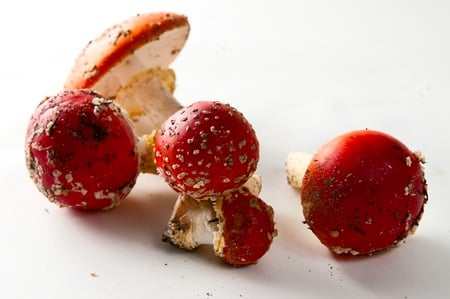
Editor’s Note: I have said this a lot in the comments before, in person and in the body of this post. Let me say it one more time, right up here in the beginning: Unless you are an expert mushroom hunter and you can 100 percent identify this mushroom, DON’T EAT IT. I wrote this post for other experts, not for just anyone to think they’ve found A. muscaria. This is serious stuff, folks. Mistake this mushroom for another amanita and you can die. Seriously. ~Hank
No mushroom presents more of an enigma than the fly agaric, Amanita muscaria. It is the most recognizable mushroom on the planet, and is widely known as the hallucinatory ‘shroom responsible for Alice’s trip into Wonderland and quite possibly our beloved images of a red-suited Santa Claus and his flying reindeer.
I am not into hallucinations. Or stomach cramping, for that matter. So for years I let this beautiful mushroom pass on my mushroom hunts. Until last weekend. We were ostensibly hunting for porcini, Boletus edulis, but as any king bolete hunter knows, the fly agaric is literally a red flag indicating that a porcino might be nestled nearby: They flush around the same time, in around the same place. And where we were on California’s Central Coast there were thousands of muscaria, a red tide in the woods.

As we walked, picking porcini and other wonderful boletes, I began having a nagging conversation with myself: You know you can eat those amanitas, right? Yes, but don’t they need all sorts of crazy processing first? Probably. But you will never get a better chance to experiment than with this flush right here, right now. OK, OK. I grabbed a separate bag and began picking.
I filled a grocery bag in no time. In fact, I could have filled the back of my pickup with muscaria. But I also had a huge haul of porcini, the prize of the day. So I dealt with them first. My dehydrator ran morning and night for days. I made porcini powder, dried quarts of porcini, made porcini risotto, and even gave some fresh ones as Christmas presents. All the while my sack of amanitas lay neglected in the garage.
I came up for air a few days ago and decided to do some research. I have a lot of mushroom books. Most say that Amanita muscaria is toxic and hallucinatory. A few call it deadly poisonous, which seems to be a stretch considering there are fewer than a handful of confirmed deaths by this mushroom and all have extenuating circumstances. (A side note: fly agaric appears to be attractive to dogs and cats and can kill them if they eat it, so keep it away from your pets!)
There is also, apparently, an entire modern subculture dedicated to tripping on this mushroom, and its use in visions dates back thousands of years — especially among those who live in the boreal forests of the north.
This is where Santa comes in. My colleague Greg Marley, whose excellent book Chanterelle Dreams, Amanita Nightmares: The Love, Lore, and Mystique of Mushrooms goes into this at length, says that fly agaric has been a symbol of yuletide happiness in Central Europe, Russia and Scandinavia for centuries, calling it “a red light shining bright in the winter darkness.” And the people of the North, as any mushroom hunter knows, are mad about mushrooms.
There is a common exchange between us Anglo ‘shroomers when we see various, “lesser” species of ‘shroom: Is it edible? Well, the Russians eat it… Amanita muscaria falls into this category.
Historically, the Siberians boiled fly agaric and then drank the pot liquor to get roaring drunk. They then preserved the mushrooms for eating later. As it happens, the Siberians’ livestock also loves this ‘shroom. And I’m not talking about cattle, I’m talking about reindeer.
Yep. Caribou will seek out Amanita muscaria just for the high — or at least it looks that way to us humans. So it’s not too far a stretch to conjure up an image of a jolly, roaringly drunk, fat, bearded dude all dressed up for the North Pole — in a red suit with white trim — chillin’ with flying reindeer.
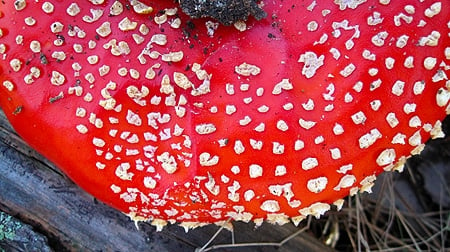
But like I said, I am not into that sort of thing. So I looked deeper. It seems that the primary toxins, er, “active ingredients,” in Amanita muscaria are ibotenic acid and muscimol. Unlike the amatoxins in the deadly amanitas — the death cap and the destroying angel — ibotenic acid and muscimol are water soluble.
More research turned up William Rubel, who knows his stuff when it comes to mushrooms. Rubel wrote an article about how to detoxify fly agaric that proved enlightening.
What’s more, he and David Arora, who is even more reknowned in the mycological world, teamed up on a longer piece (which is linked to at the bottom of Rubel’s article) about cultural attitudes toward Amanita muscaria that provides all the detail you could need on why this mushroom has such a varied place in our minds: Food. Poison. Hallucinogen.
As food, fly agaric does need special handling. Apparently most people eat only the caps or the very young buttons. They must be boiled in a large volume of water for a period of time, and then you need to toss out that water. After that, most cultures will either fry them like normal mushrooms, or pickle them, or preserve them in oil; I happen to know that a certain set of Italians do this. The Japanese around Nagano eat Amanita muscaria as pickles, as do the Lithuanians, Finns and Russians.
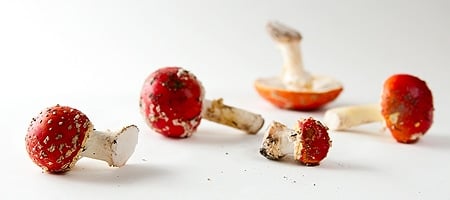
My friend Langdon Cook wrote about eating fly agaric with none other than David Arora, and he pronounced them delicious. Lang also pointed me to a cautionary article written by two mycologists who, apparently, failed to detoxify their muscaria enough. The moral of that article is to use lots of water and boil the hell out of the shrooms.
Back to my grocery bag. By the time I’d screwed up enough courage to mess around with these things, about half had gone by. Bummer. But I still had about 10 good caps to experiment with. What follows is what I did to detoxify the mushrooms. If you choose to play around with Amanita muscaria, do so at your own risk.
- I first removed all the caps and cleaned them with a brush and the side of a knife. Then I cut the caps into 1/4 inch slices.
- I filled my 12-quart stockpot up to the top, leaving about 3 inches of room to spare. I added enough salt to make the water taste salty and 1 cup of cider vinegar. Several sources say that adding salt and vinegar helps extract the toxins.
- I brought this to a boil and added the mushroom caps, then let it roll for 15 minutes.
- I then drained the mushrooms and filled the stockpot half full with fresh water and brought that to a boil. In went the mushrooms for another 5 minutes. Why? If they had gotten too vinegary or salty, this would help. Also, better safe than sorry.
The key to boiling seems to be time and water volume. You need enough water to leach out all the toxins of the mushroom, so it follows that the more muscaria you boil, the more water you’ll need. As for time, it seems 15 minutes is a pretty good interval, according to my sources.
When the slices were done with this treatment, almost all the color was gone from the previously pretty red caps. Oh well. They were still a vague ivory-yellow, but the mushrooms themselves were pale and slippery. Not appetizing. Lang and Arora ate them fried in butter, so I did the same.
I experimented with about 1 cap’s worth of slices. It is always wise to start small with any new mushroom, and especially one that has potentially toxic effects. I put the slices into a non-stick pan and let them dry saute for a few minutes. They did not exude too much water, oddly, so I added some butter and a little salt. I was happy to see the slices fry up crispy. Now we’re talking!
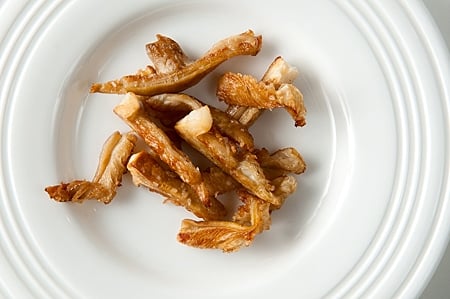
I put them on a little plate, and tentatively took a bite. I’d be lying if I told you I was not at least a little nervous. I tasted butter and salt at first, always nice, but then I got a little crisp, then the squinchy crunchiness of the mushroom, then that nutty flavor everyone who’s eaten muscaria talks about. Reflexively, I reached for another slice, then another and another.
I had to force myself to stop at 1 cap’s worth. They were that good. Now it was time to wait.
The mycologists who’d boiled their muscaria in too little water for too short a time started tripping at 20 minutes. So I sat down to watch Boise State beat the crap out of Arizona State and waited. I was wondering if Boise’s crazy blue uniforms would spark some weird hallucination. But no. I looked at my watch: 45 minutes and nothing. The game got boring. Holly and I then watched a show about a bunch of Vikings getting beheaded in England 1000 years ago, which, in retrospect, was probably not ideal if I were about to go on a mushroom trip. But no. I looked at my watch again: Two hours had passed and nothing.
If a trip were coming, it would have hit by then. What’s more, I had neither stomach cramps nor any other ill effects whatsoever. Success!
Now you may be asking yourself why I would bother messing around with Amanita muscaria when I had just hauled in pounds of boletes? First off, fly agaric is one of the easiest mushrooms in the world to identify. Even though it has some color variation, like the yellow-orange one below, if you stick to the red and orange color phases Amanita muscaria is unmistakable.
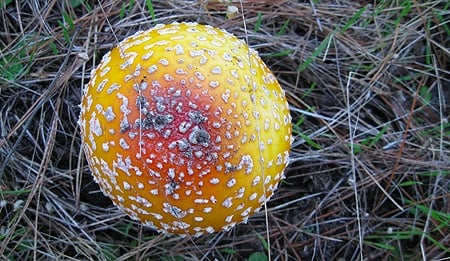
Now white and light-yellow phase muscaria do exist, but I do not recommend messing with those. White amanitas are almost always deadly — the destroying angel chief among them — and mistaking a destroying angel for a white muscaria will be the last mistake you ever make.
And with the yellow ones, you can mistake muscaria for the more-toxic Panther Amanita, Amanita pantherina, which does not have a history of culinary use.
A second reason to consider eating fly agaric is because it is a large mushroom that, as I saw on the Central Coast, can flush in huge numbers. I could easily have collected four grocery bags of them on my last trip, which would have made for lots of good eating down the line.
And good eating is the real reason I will choose to eat Amanita muscaria once or twice a season. It was a delicious mushroom fried in butter, and I suspect it will make an even better preserved mushroom, if the Italians or Russians’ experience is any indication. At the very least, it will be a conversation starter, eh?





Totally useless comment: I first encountered the name in reading about the history of Siberia’s Chukchi inhabitants in 1150 give or take. The Rus–gun, swords, a bona fide military force–could NOT defeat these Eskimo-type northern steppe dwellers. One Rus military leader hypothesized that they were maybe too blasted on “Fly agaric” mushrooms to tire, want the battle to end…and so they just kept on fighting, driving away the [medieval] Rus troops….Funny, never mind historical accuracy….
So does it still halucinetic after its been boiled?
Nathan: No. That’s the point.
Thank you for the article! We have one giant red FlyAgaric growing in our yard once a year. (I live in SF Bay Area) and I’m always so tempted to harvest it and boil it up. A little hallucinogenic experience would be interesting (if I ever had some free/down time) but I have never touched the beauties. (And don’t have ANY wild mushroom foraging experience). I won’t be picking or boiling or sauteeding any mushroom I find, but I AM terribly curious about the craft. I would love to know more. Do you have any suggestions on where to start learning more?
On another note, it seems some creature has been to visit the magic mushroom ?, because it has several bites out of it. (My guess is theres a raccoon or a squirrel tripping out somewhere in my trees…)
Thanks again for the article, and for being the brave soul to try this as food!
Liz
I can verify the Arora/Rubel method for detoxifying A. muscaria for consumption as food. It’s time-consuming, and maybe not worth doing more than once or twice experimentally if you have only a small quantity of mushroom. A larger haul would, for me, make all the boiling and straining and re-boiling worthwhile. It’s a decent culinary mushroom, but more of a textural ingredient than a savory one after all that boiling.
Have you come across and pickling recipes?
David: not for this mushroom. But I know they exist. I think the Japanese pickle them.
Hi Hank, I recently found a mushroom I believe to be Amanita muscaria, but I am an extremely novice mushroom gatherer and I really want to make sure I’ve got the right thing before I consume it. Is there anyway I could possibly email you some pictures of it and you could let me know ? I’d really appreciate it 🙂
Olivia: Don’t eat it. This is not a mushroom for novices.
This spring while hunting morels and snowballs, I picked two yellow amanita muscaria, intending to take them back to camp to identify. I forgot about them and soaked them for a couple of hours with the other mushrooms. When I drained & cleaned the mushrooms I pulled out the mature one, but forgot about the other that looked like a snowball. We accidentally fried it ate it. My companions got sick within a half hour. I fell fast asleep and woke up feeling slightly elevated, with a very pleasant sensation that lasted most of the day through hiking and kayaking. It was lovely. But I felt very foolish about having been so careless I consider myself very lucky and will probably just stick to morels next year.
Folks, I just want to share that I have been trying to get high with these mushrooms for a few years and I can report that sun drying them and eating them raw had zero effect other than they were delicious chewy snack. Sweet nutty chewy delicious.
I’m about to attempt a honey mead with them to extract the taste of the rainbow and dance with the little people.
I once read that the Russians peeled the caps, chopped them up and boiled them in a samovar; the women drank the tea first, and the men drank their pee. I assume it was a process worth repeating.
I believe at the Yahoo group Mushroomtalk, we’ve had 1st hand account(s) of eating the panther after parboiling.
Sam
I fried about 1 TSP of aminita agaricus and ate it. (Did not boil first) No problem. So next day tried 1/3 cup. It took about 3 hours and I began feeling light headed and dizzy. At the 4th hour, vomited it up(thank goodness). Remained dizzy for another 7 hours. (I mistakenly thought I was eating a Caesars aminita). hours later I still feel OK. 19 hours later, at this posting, I’m feeling normal again. Will post if symptoms change.
They don’t make you trip. They make you feel drunk or send you into a trance/dream. Heat a fresh one at 50 degrees for 10 minutes or so, if you do it right you’l only need 1.
Ate a cap raw, made me very aware of my surroundings.
On the toxicity of hallucinogens generally, i would just like to add that, in my experience, effects can vary from one person to the next. A friend of mine ate a freshly picked amanita muscaria straight down for a dare with no effect……..I did just 20 liberty cap and almost didn’t come back…..when, even enough for anything but a mild trip was the ‘common wisdom’ of the time.
Needless to say i have a profound respect, fascination but also fear of this amazing aspect of our world.
Finns don’ eat them either.
Bridget,
Casually touching a cap? Not a problem. But it’s a matter of degree and dosage.
If you merely handle large amounts of wet muscaria over time, like one fellow I know who dried a bunch of muscaria caps, and another Professor that I know whose students were testing muscaria and pantherina for ibotenic acid levels in his college lab, without wearing gloves, you can indeed absorb some of those toxins right through your skin, enough to feel some of those unpleasant altho certainly not fatal effects. You would have to actually eat a large amount of unboiled muscaria to get to the point of convulsions or coma or even death.
One can actually eat a single small slice of muscaria unboiled, and feel nothing but pleasure at its flavor (I have done this, once). Like I said, dose dependent. But I don’t recommend eating muscaria, whether boiled first or merely panfried or merely eaten dried for a more trippy experience.
Just because you can do something, doesn’t mean that it is a good idea, for all. And that is beyond the issue of whether your amanita ID skills are up to par!
Interesting historical info on guessowii, or the yellow eastern muscaria, which was missed by Rubel or at least not remarked on in his paper (nor in mine; you have to stop at some point, or you end up with a book!) … apparently some populations of this mushroom in the NE are wholly nontoxic. Over a hundred years ago, Charles Peck, the official NY state botanist, received much correspondence about both plants and fungi. At least three people wrote him that they had eaten yellow muscaria as an edible species without any special preparation at all, and were unharmed and not inebriated afterwards. But of course, that’s a bit of Russian Roulette, and you can’t assume that your particular patch of guessowii is wholly non-toxic. There was also a report to Peck of a sheep that ate yellow muscaria and suffered no adverse effects. Even other animals get “high” from ingesting the ibotenic acid and muscimol found in muscaria, pantherina, etc., and they behave in a bizarre a manner, just like we would if we ate it unboiled.
Despite that handful of folks who ate apparently non-toxic yellow muscaria, and those who also reported parboiling it first to remove toxins, Peck was unambiguous in his recommendations: he considered muscaria to be a DEADLY amanita, on a par with phalloides. In hindsight, we no longer believe this to be true (the deadly part, at least not like phalloides is deadly), but muscaria is indeed a highly toxic and potentially dangerous mushroom. We have to wonder what happened to folks in the past that it had the widespread reputation of being deadly? Were folks actually dying from eating muscaria? I tried very hard to track down the truth, but could find no proof one way or the other in the historical record. Physicians writing at the same time as Peck commonly called it deadly, but I couldn’t find revealing case studies.
As to Lithuanians eating muscaria as food … I wonder if this was or is really widespread. Certainly there are differences of opinion around the world, even in countries where a few individuals do indeed prepare muscaria as an edible species. Rubel’s wife is Lithuanian, so I suppose that really doesn’t count if she only began to eat it recently. I do believe that it was David Arora who first alerted Rubel to muscaria’s potential as an edible species, after Arora had traveled to the Nagano Region of Japan and observed locals gathering muscaria while he filled his basket with porcini.
There is a verifiable history of Lithuanians using muscaria as an inebriant, and there is still a lively online market for dried caps of “potent” Lithuanian muscaria for “research” purposes. I could find no real evidence of it being an accepted edible species in Lithuania, however.
Altho a few Russians may also eat muscaria pickled (they pretty much eat every mushroom pickled), the vast majority of Russians shun muscaria as a well known, highly toxic mushroom. And no one can accuse the Russians of being a fungi phobic society!
As Hank has rightly pointed out, this is a well storied mushroom, with both proponents (for its entheogenic properties or its medicinal properties or even, rarely, as an edible species) and those who rightly fear it. It is always a fascinating topic for discussion, but just like your Momma told you, you don’t have to put everything into your mouth.
Thanks Hank, for hosting this very interesting thread.
The orange/yellow ones are not amanita muscaria. They are amanita guessowii. Handle and prepare like muscaria.
Is it true that they are even unsafe to touch w/bare hands??? I don’t know much about mushrooms other than they are delicious but my Mom always warned us to not touch the red ones.
Bridgit: Nope, not true.
Hello. I am Lithuanian who grew up in Dzukija (south Lithuanian region famous for its mushrooms). Ive spent all my childhood and younger years in the forests and can name all mushrooms in my region. What you have said about Lithuanians eating this mushroom is TOTAL LIE. This is in fact the first mushroom our mums tell not to touch, pick or eat. Don’t spread the lies please…
Aina: Sounds like your mom was different from the Lithuanians I know. Your family’s experience may be different from others’.
This year (2015) was a bust on amanita AND porcini (and chanterelle, and chicken of the woods, and…) because I do have a market for dried caps, but I know several SE Asians and a few Euro transplants that peel the red skin off then eat them, no parboiling, just saute. With autoimmune disorders, it’s not something I want to try if something went ‘wrong’, I already deal with muscle cramps/spasms, nausea, etc. I’d love to be able to get out for morel season, though. Near Long Beach, WA, found a truckload of elfin saddle…NOT edible, but funky looking. The other gyromitra someone mentioned I think is that they call a ‘brain’ mushroom in E. WA/Idaho. But what they call a cauliflower over there is a coral mushroom (HUGE clusters, can be a foot or more in diameter), unlike the cauliflower on this side of the Cascades that looks like a bowl of cooked egg noodles.